视觉里程计:2D-2D 对极几何、3D-2D PnP、3D-3D ICP
2024-09-30 15:34:25

参考链接:https://mp.weixin.qq.com/s/89IHjqnw-JJ1Ak_YjWdHvA
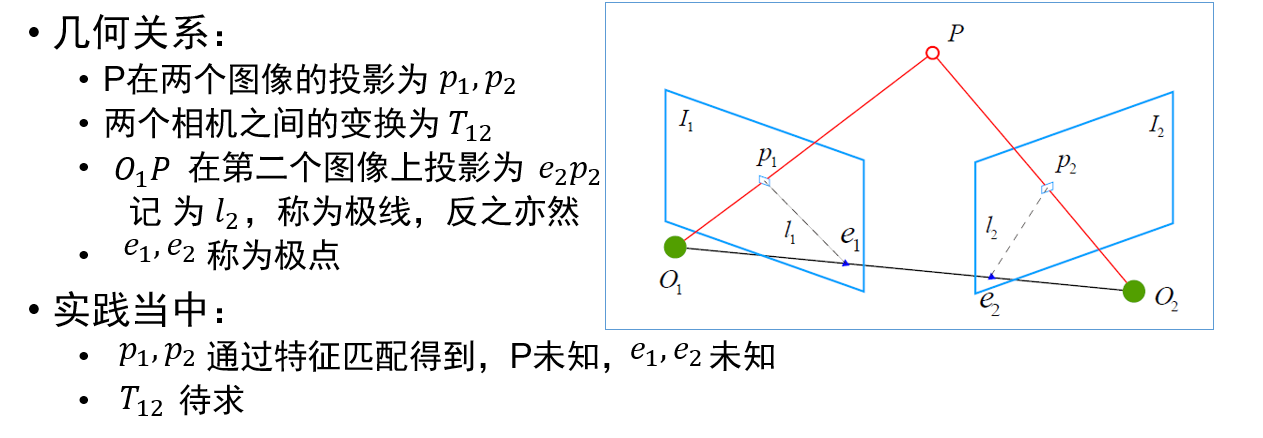
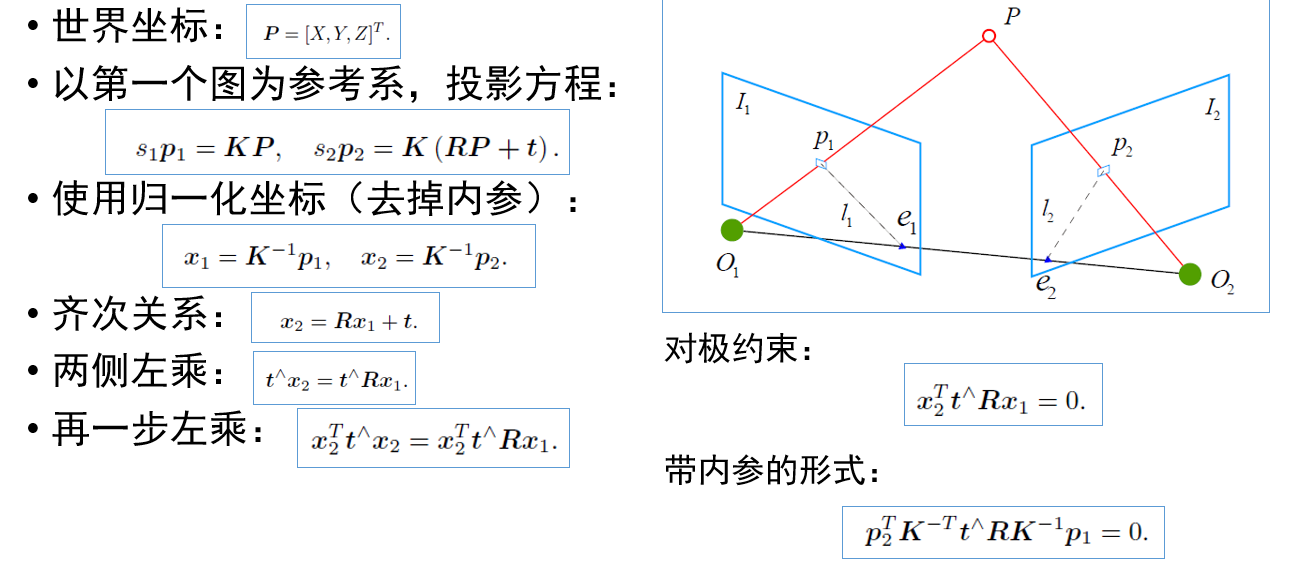
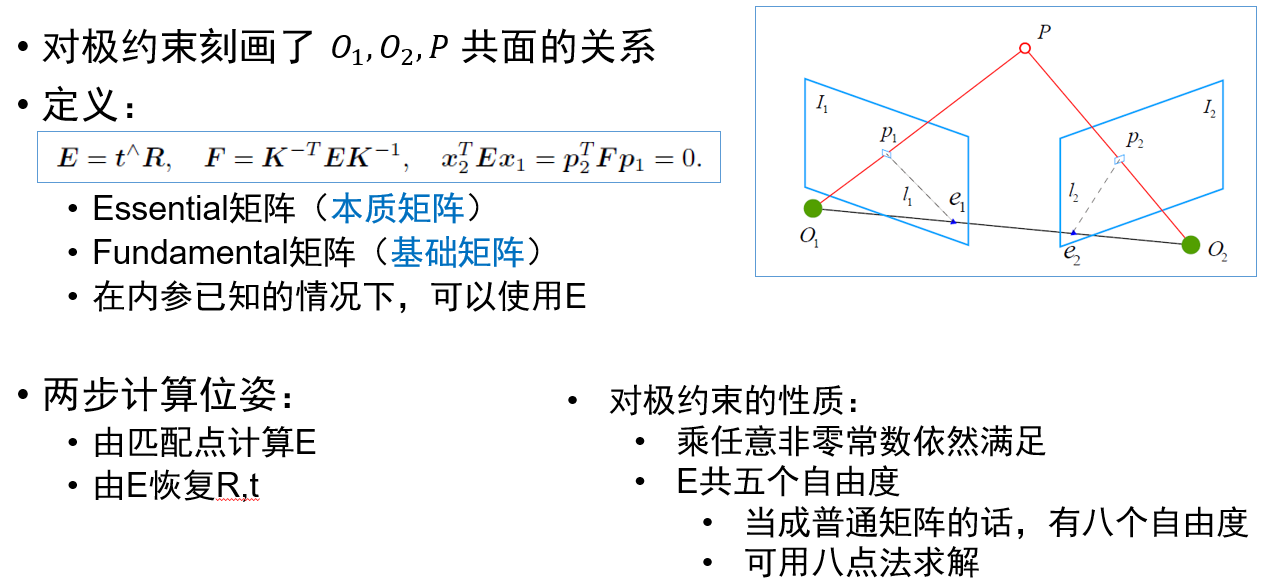

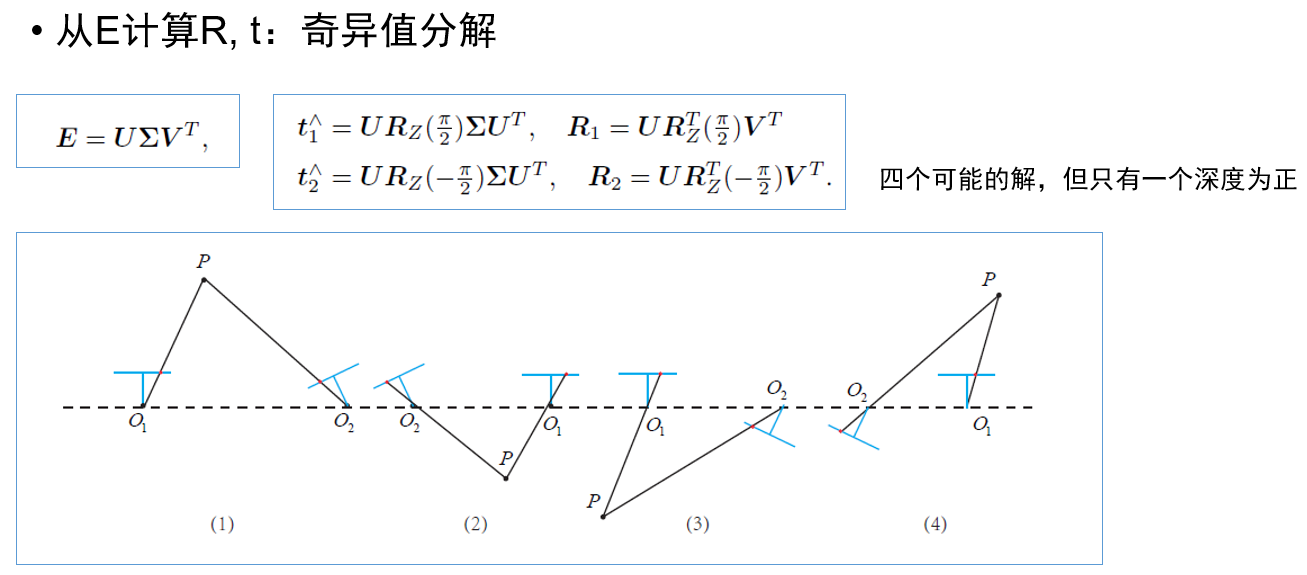


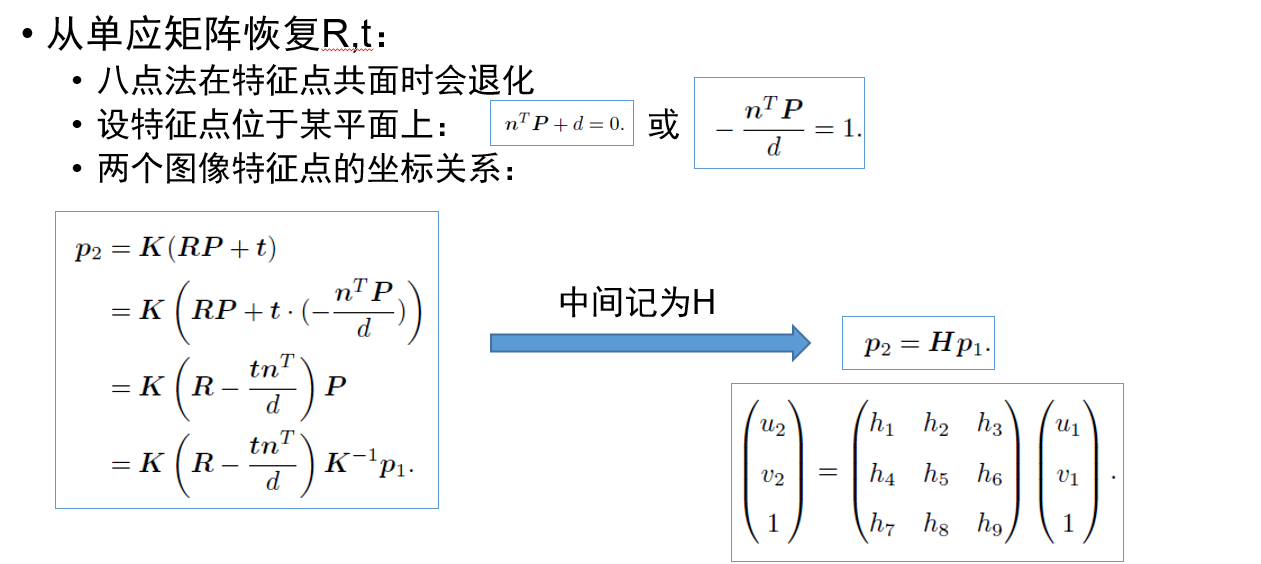
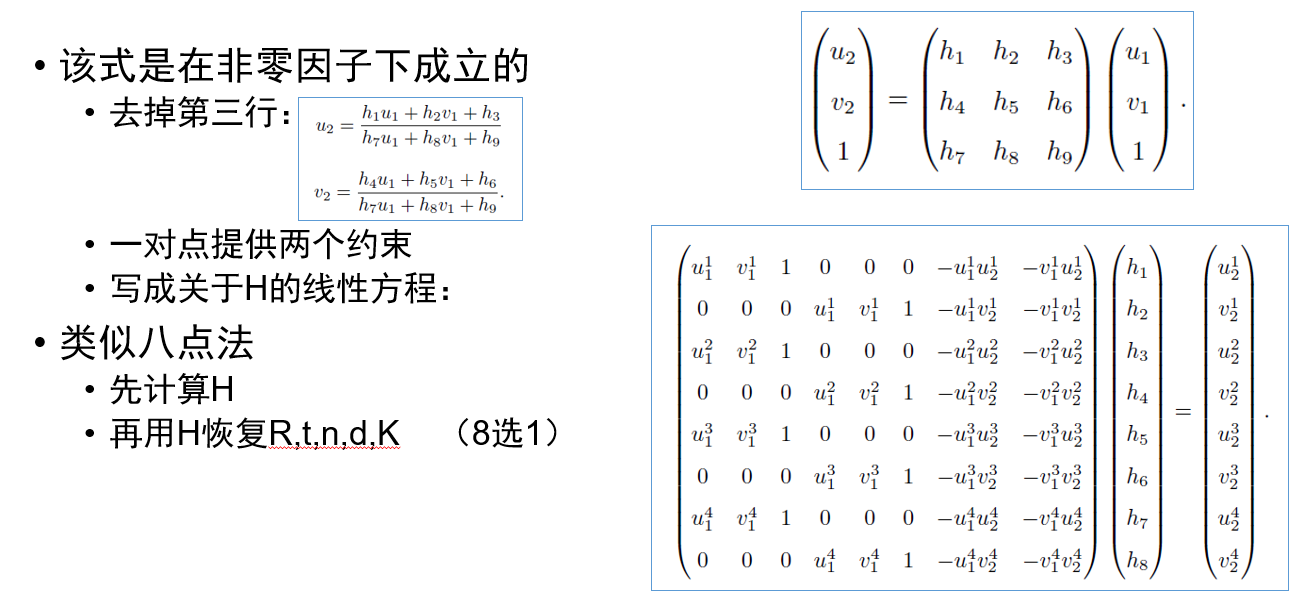
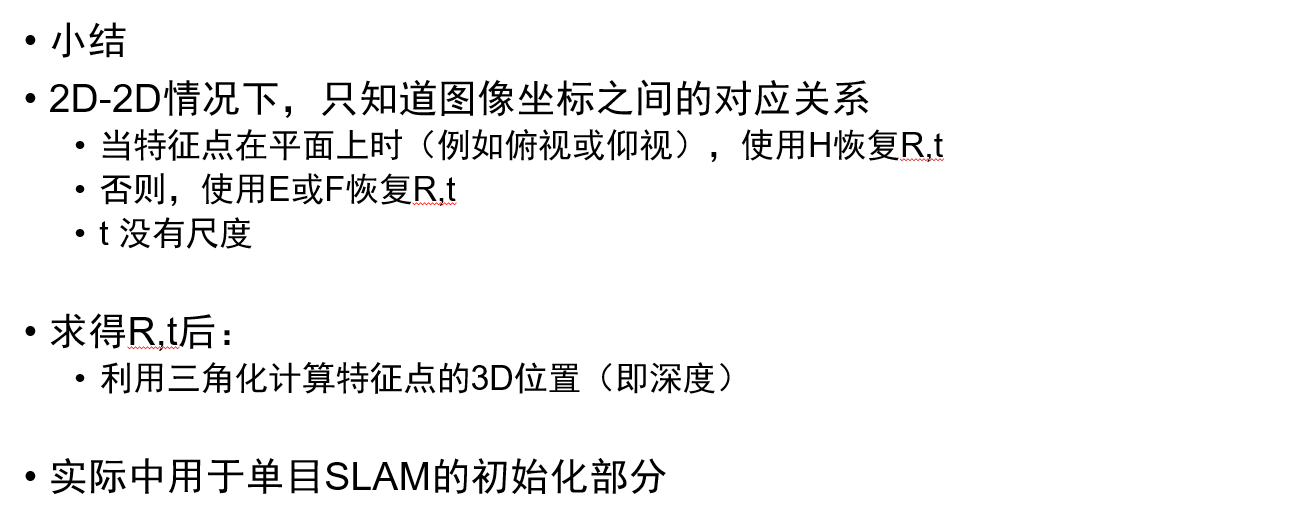
#include <iostream>
#include <opencv2/core/core.hpp>
#include <opencv2/features2d/features2d.hpp>
#include <opencv2/highgui/highgui.hpp>
#include <opencv2/calib3d/calib3d.hpp>
// #include "extra.h" // use this if in OpenCV2 using namespace std;
using namespace cv; /****************************************************
* 本程序演示了如何使用2D-2D的特征匹配估计相机运动
* **************************************************/ void find_feature_matches(
const Mat &img_1, const Mat &img_2,
std::vector<KeyPoint> &keypoints_1,
std::vector<KeyPoint> &keypoints_2,
std::vector<DMatch> &matches); void pose_estimation_2d2d(
std::vector<KeyPoint> keypoints_1,
std::vector<KeyPoint> keypoints_2,
std::vector<DMatch> matches,
Mat &R, Mat &t); // 像素坐标转相机归一化坐标
Point2d pixel2cam(const Point2d &p, const Mat &K); int main(int argc, char **argv) {
if (argc != ) {
cout << "usage: pose_estimation_2d2d img1 img2" << endl;
return ;
}
//-- 读取图像
Mat img_1 = imread(argv[], CV_LOAD_IMAGE_COLOR);
Mat img_2 = imread(argv[], CV_LOAD_IMAGE_COLOR);
assert(img_1.data && img_2.data && "Can not load images!"); vector<KeyPoint> keypoints_1, keypoints_2;
vector<DMatch> matches;
find_feature_matches(img_1, img_2, keypoints_1, keypoints_2, matches);
cout << "一共找到了" << matches.size() << "组匹配点" << endl; //-- 估计两张图像间运动
Mat R, t;
pose_estimation_2d2d(keypoints_1, keypoints_2, matches, R, t); //-- 验证E=t^R*scale
Mat t_x =
(Mat_<double>(, ) << , -t.at<double>(, ), t.at<double>(, ),
t.at<double>(, ), , -t.at<double>(, ),
-t.at<double>(, ), t.at<double>(, ), ); cout << "t^R=" << endl << t_x * R << endl; //-- 验证对极约束
Mat K = (Mat_<double>(, ) << 520.9, , 325.1, , 521.0, 249.7, , , );
for (DMatch m: matches) {
Point2d pt1 = pixel2cam(keypoints_1[m.queryIdx].pt, K);
Mat y1 = (Mat_<double>(, ) << pt1.x, pt1.y, );
Point2d pt2 = pixel2cam(keypoints_2[m.trainIdx].pt, K);
Mat y2 = (Mat_<double>(, ) << pt2.x, pt2.y, );
Mat d = y2.t() * t_x * R * y1;
cout << "epipolar constraint = " << d << endl;
}
return ;
} void find_feature_matches(const Mat &img_1, const Mat &img_2,
std::vector<KeyPoint> &keypoints_1,
std::vector<KeyPoint> &keypoints_2,
std::vector<DMatch> &matches) {
//-- 初始化
Mat descriptors_1, descriptors_2;
// used in OpenCV3
Ptr<FeatureDetector> detector = ORB::create();
Ptr<DescriptorExtractor> descriptor = ORB::create();
// use this if you are in OpenCV2
// Ptr<FeatureDetector> detector = FeatureDetector::create ( "ORB" );
// Ptr<DescriptorExtractor> descriptor = DescriptorExtractor::create ( "ORB" );
Ptr<DescriptorMatcher> matcher = DescriptorMatcher::create("BruteForce-Hamming");
//-- 第一步:检测 Oriented FAST 角点位置
detector->detect(img_1, keypoints_1);
detector->detect(img_2, keypoints_2); //-- 第二步:根据角点位置计算 BRIEF 描述子
descriptor->compute(img_1, keypoints_1, descriptors_1);
descriptor->compute(img_2, keypoints_2, descriptors_2); //-- 第三步:对两幅图像中的BRIEF描述子进行匹配,使用 Hamming 距离
vector<DMatch> match;
//BFMatcher matcher ( NORM_HAMMING );
matcher->match(descriptors_1, descriptors_2, match); //-- 第四步:匹配点对筛选
double min_dist = , max_dist = ; //找出所有匹配之间的最小距离和最大距离, 即是最相似的和最不相似的两组点之间的距离
for (int i = ; i < descriptors_1.rows; i++) {
double dist = match[i].distance;
if (dist < min_dist) min_dist = dist;
if (dist > max_dist) max_dist = dist;
} printf("-- Max dist : %f \n", max_dist);
printf("-- Min dist : %f \n", min_dist); //当描述子之间的距离大于两倍的最小距离时,即认为匹配有误.但有时候最小距离会非常小,设置一个经验值30作为下限.
for (int i = ; i < descriptors_1.rows; i++) {
if (match[i].distance <= max( * min_dist, 30.0)) {
matches.push_back(match[i]);
}
}
} Point2d pixel2cam(const Point2d &p, const Mat &K) {
return Point2d
(
(p.x - K.at<double>(, )) / K.at<double>(, ),
(p.y - K.at<double>(, )) / K.at<double>(, )
);
} void pose_estimation_2d2d(std::vector<KeyPoint> keypoints_1,
std::vector<KeyPoint> keypoints_2,
std::vector<DMatch> matches,
Mat &R, Mat &t) {
// 相机内参,TUM Freiburg2
Mat K = (Mat_<double>(, ) << 520.9, , 325.1, , 521.0, 249.7, , , ); //-- 把匹配点转换为vector<Point2f>的形式
vector<Point2f> points1;
vector<Point2f> points2; for (int i = ; i < (int) matches.size(); i++) {
points1.push_back(keypoints_1[matches[i].queryIdx].pt);
points2.push_back(keypoints_2[matches[i].trainIdx].pt);
} //-- 计算基础矩阵
Mat fundamental_matrix;
fundamental_matrix = findFundamentalMat(points1, points2, CV_FM_8POINT);
cout << "fundamental_matrix is " << endl << fundamental_matrix << endl; //-- 计算本质矩阵
Point2d principal_point(325.1, 249.7); //相机光心, TUM dataset标定值
double focal_length = ; //相机焦距, TUM dataset标定值
Mat essential_matrix;
essential_matrix = findEssentialMat(points1, points2, focal_length, principal_point);
cout << "essential_matrix is " << endl << essential_matrix << endl; //-- 计算单应矩阵
//-- 但是本例中场景不是平面,单应矩阵意义不大
Mat homography_matrix;
homography_matrix = findHomography(points1, points2, RANSAC, );
cout << "homography_matrix is " << endl << homography_matrix << endl; //-- 从本质矩阵中恢复旋转和平移信息.
// 此函数仅在Opencv3中提供
recoverPose(essential_matrix, points1, points2, R, t, focal_length, principal_point);
cout << "R is " << endl << R << endl;
cout << "t is " << endl << t << endl; }




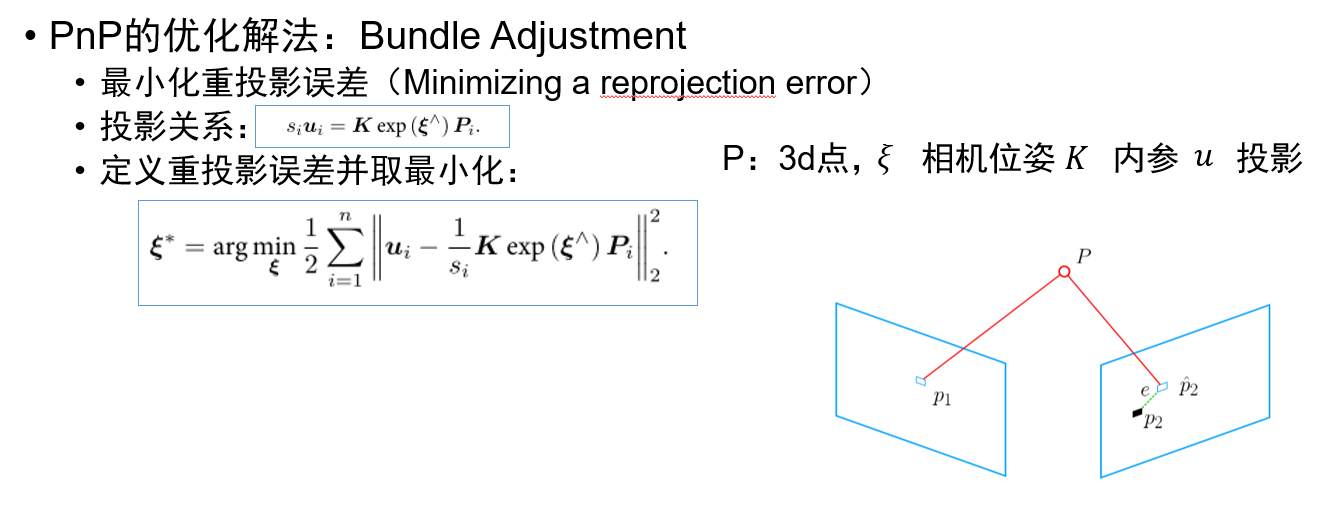

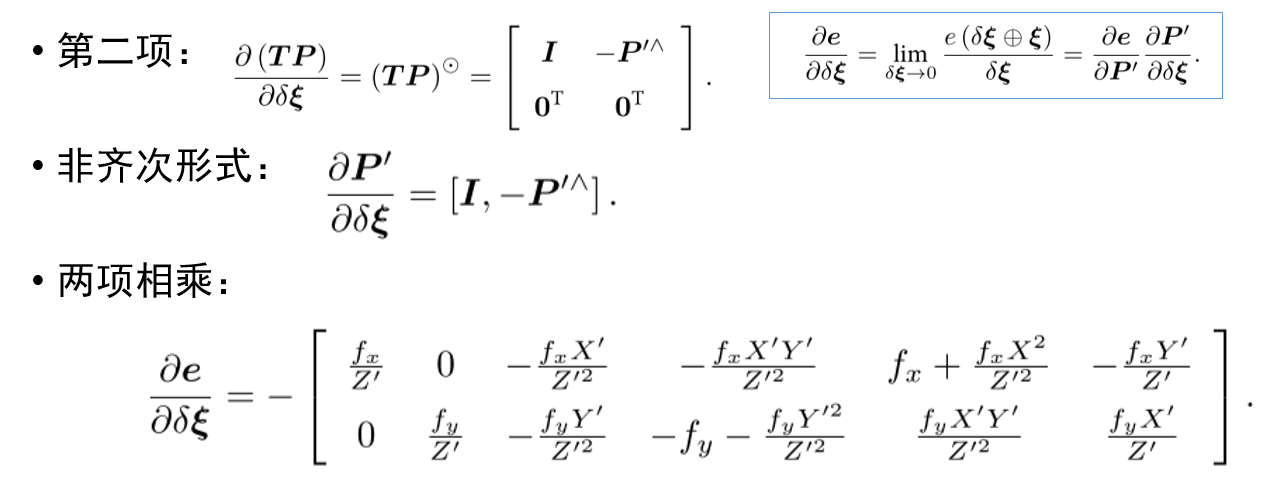
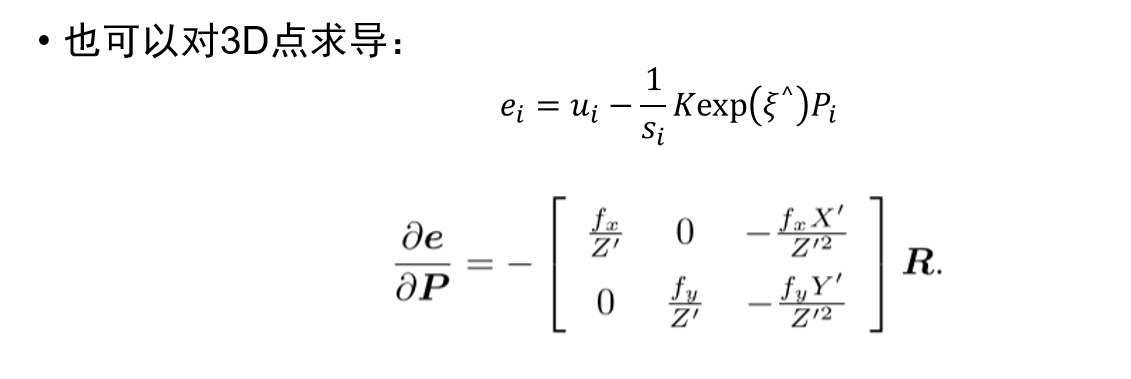
#include <iostream>
#include <opencv2/opencv.hpp>
// #include "extra.h" // used in opencv2
using namespace std;
using namespace cv; void find_feature_matches(
const Mat &img_1, const Mat &img_2,
std::vector<KeyPoint> &keypoints_1,
std::vector<KeyPoint> &keypoints_2,
std::vector<DMatch> &matches); void pose_estimation_2d2d(
const std::vector<KeyPoint> &keypoints_1,
const std::vector<KeyPoint> &keypoints_2,
const std::vector<DMatch> &matches,
Mat &R, Mat &t); void triangulation(
const vector<KeyPoint> &keypoint_1,
const vector<KeyPoint> &keypoint_2,
const std::vector<DMatch> &matches,
const Mat &R, const Mat &t,
vector<Point3d> &points
); /// 作图用
inline cv::Scalar get_color(float depth) {
float up_th = , low_th = , th_range = up_th - low_th;
if (depth > up_th) depth = up_th;
if (depth < low_th) depth = low_th;
return cv::Scalar( * depth / th_range, , * ( - depth / th_range));
} // 像素坐标转相机归一化坐标
Point2f pixel2cam(const Point2d &p, const Mat &K); int main(int argc, char **argv) {
if (argc != ) {
cout << "usage: triangulation img1 img2" << endl;
return ;
}
//-- 读取图像
Mat img_1 = imread(argv[], CV_LOAD_IMAGE_COLOR);
Mat img_2 = imread(argv[], CV_LOAD_IMAGE_COLOR); vector<KeyPoint> keypoints_1, keypoints_2;
vector<DMatch> matches;
find_feature_matches(img_1, img_2, keypoints_1, keypoints_2, matches);
cout << "一共找到了" << matches.size() << "组匹配点" << endl; //-- 估计两张图像间运动
Mat R, t;
pose_estimation_2d2d(keypoints_1, keypoints_2, matches, R, t); //-- 三角化
vector<Point3d> points;
triangulation(keypoints_1, keypoints_2, matches, R, t, points); //-- 验证三角化点与特征点的重投影关系
Mat K = (Mat_<double>(, ) << 520.9, , 325.1, , 521.0, 249.7, , , );
Mat img1_plot = img_1.clone();
Mat img2_plot = img_2.clone();
for (int i = ; i < matches.size(); i++) {
// 第一个图
float depth1 = points[i].z;
cout << "depth: " << depth1 << endl;
Point2d pt1_cam = pixel2cam(keypoints_1[matches[i].queryIdx].pt, K);//由匹配点的像素坐标得到相机坐标
cv::circle(img1_plot, keypoints_1[matches[i].queryIdx].pt, , get_color(depth1), );//画出匹配点,颜色由深度决定 // 第二个图
Mat pt2_trans = R * (Mat_<double>(, ) << points[i].x, points[i].y, points[i].z) + t;
float depth2 = pt2_trans.at<double>(, );
cv::circle(img2_plot, keypoints_2[matches[i].trainIdx].pt, , get_color(depth2), );
}
cv::imshow("img 1", img1_plot);
cv::imshow("img 2", img2_plot);
cv::waitKey(); return ;
} void find_feature_matches(const Mat &img_1, const Mat &img_2,
std::vector<KeyPoint> &keypoints_1,
std::vector<KeyPoint> &keypoints_2,
std::vector<DMatch> &matches) {
//-- 初始化
Mat descriptors_1, descriptors_2;
// used in OpenCV3
Ptr<FeatureDetector> detector = ORB::create();
Ptr<DescriptorExtractor> descriptor = ORB::create();
// use this if you are in OpenCV2
// Ptr<FeatureDetector> detector = FeatureDetector::create ( "ORB" );
// Ptr<DescriptorExtractor> descriptor = DescriptorExtractor::create ( "ORB" );
Ptr<DescriptorMatcher> matcher = DescriptorMatcher::create("BruteForce-Hamming");
//-- 第一步:检测 Oriented FAST 角点位置
detector->detect(img_1, keypoints_1);
detector->detect(img_2, keypoints_2); //-- 第二步:根据角点位置计算 BRIEF 描述子
descriptor->compute(img_1, keypoints_1, descriptors_1);
descriptor->compute(img_2, keypoints_2, descriptors_2); //-- 第三步:对两幅图像中的BRIEF描述子进行匹配,使用 Hamming 距离
vector<DMatch> match;
// BFMatcher matcher ( NORM_HAMMING );
matcher->match(descriptors_1, descriptors_2, match); //-- 第四步:匹配点对筛选
double min_dist = , max_dist = ; //找出所有匹配之间的最小距离和最大距离, 即是最相似的和最不相似的两组点之间的距离
for (int i = ; i < descriptors_1.rows; i++) {
double dist = match[i].distance;
if (dist < min_dist) min_dist = dist;
if (dist > max_dist) max_dist = dist;
} printf("-- Max dist : %f \n", max_dist);
printf("-- Min dist : %f \n", min_dist); //当描述子之间的距离大于两倍的最小距离时,即认为匹配有误.但有时候最小距离会非常小,设置一个经验值30作为下限.
for (int i = ; i < descriptors_1.rows; i++) {
if (match[i].distance <= max( * min_dist, 30.0)) {
matches.push_back(match[i]);
}
}
} void pose_estimation_2d2d(
const std::vector<KeyPoint> &keypoints_1,
const std::vector<KeyPoint> &keypoints_2,
const std::vector<DMatch> &matches,
Mat &R, Mat &t) {
// 相机内参,TUM Freiburg2
Mat K = (Mat_<double>(, ) << 520.9, , 325.1, , 521.0, 249.7, , , ); //-- 把匹配点转换为vector<Point2f>的形式
vector<Point2f> points1;
vector<Point2f> points2; for (int i = ; i < (int) matches.size(); i++) {
points1.push_back(keypoints_1[matches[i].queryIdx].pt);
points2.push_back(keypoints_2[matches[i].trainIdx].pt);
} //-- 计算本质矩阵
Point2d principal_point(325.1, 249.7); //相机主点, TUM dataset标定值
int focal_length = ; //相机焦距, TUM dataset标定值
Mat essential_matrix;
essential_matrix = findEssentialMat(points1, points2, focal_length, principal_point); //-- 从本质矩阵中恢复旋转和平移信息.
recoverPose(essential_matrix, points1, points2, R, t, focal_length, principal_point);
} void triangulation(
const vector<KeyPoint> &keypoint_1,
const vector<KeyPoint> &keypoint_2,
const std::vector<DMatch> &matches,
const Mat &R, const Mat &t,
vector<Point3d> &points) {
Mat T1 = (Mat_<float>(, ) <<
, , , ,
, , , ,
, , , );
Mat T2 = (Mat_<float>(, ) <<
R.at<double>(, ), R.at<double>(, ), R.at<double>(, ), t.at<double>(, ),
R.at<double>(, ), R.at<double>(, ), R.at<double>(, ), t.at<double>(, ),
R.at<double>(, ), R.at<double>(, ), R.at<double>(, ), t.at<double>(, )
); Mat K = (Mat_<double>(, ) << 520.9, , 325.1, , 521.0, 249.7, , , );
vector<Point2f> pts_1, pts_2;
for (DMatch m:matches) {
// 将像素坐标转换至相机坐标
pts_1.push_back(pixel2cam(keypoint_1[m.queryIdx].pt, K));
pts_2.push_back(pixel2cam(keypoint_2[m.trainIdx].pt, K));
} Mat pts_4d;
cv::triangulatePoints(T1, T2, pts_1, pts_2, pts_4d); // 转换成非齐次坐标
for (int i = ; i < pts_4d.cols; i++) {
Mat x = pts_4d.col(i);
x /= x.at<float>(, ); // 归一化
Point3d p(
x.at<float>(, ),
x.at<float>(, ),
x.at<float>(, )
);
points.push_back(p);
}
} Point2f pixel2cam(const Point2d &p, const Mat &K) {
return Point2f
(
(p.x - K.at<double>(, )) / K.at<double>(, ),
(p.y - K.at<double>(, )) / K.at<double>(, )
);
}

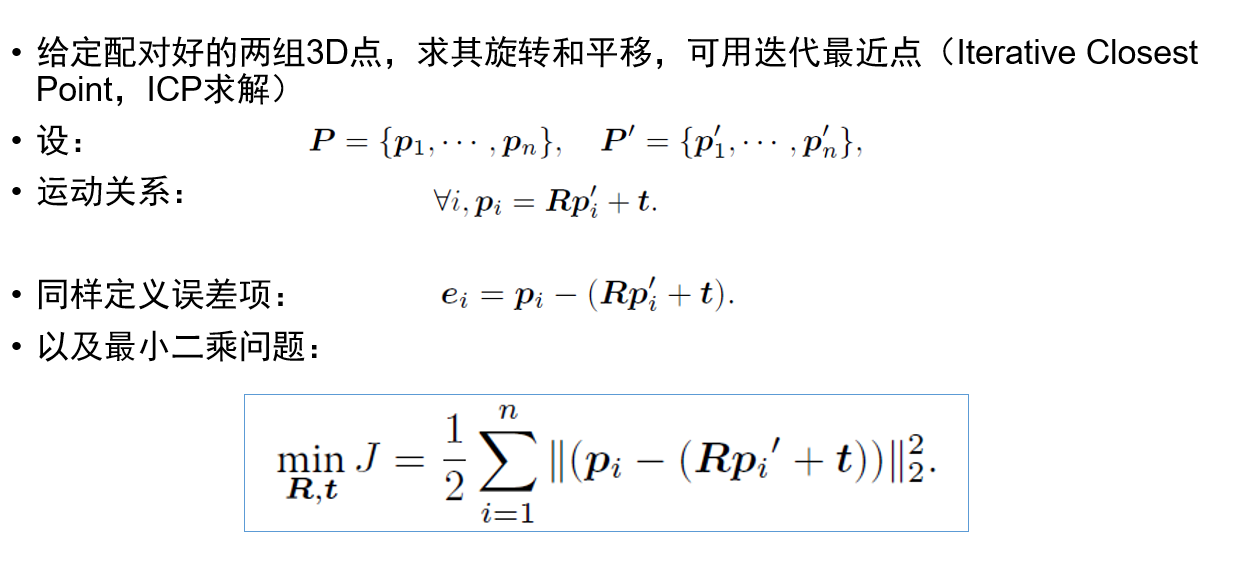



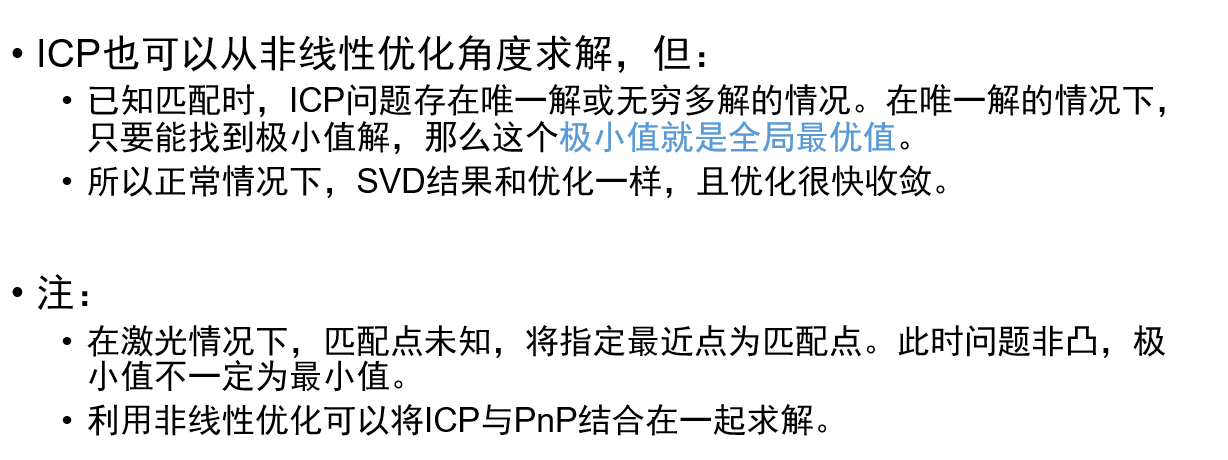

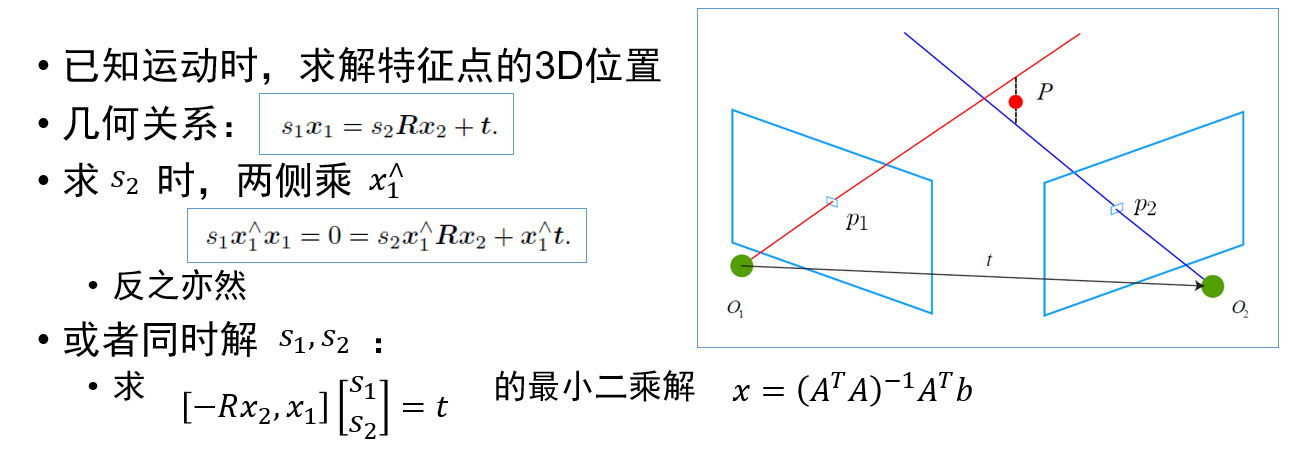
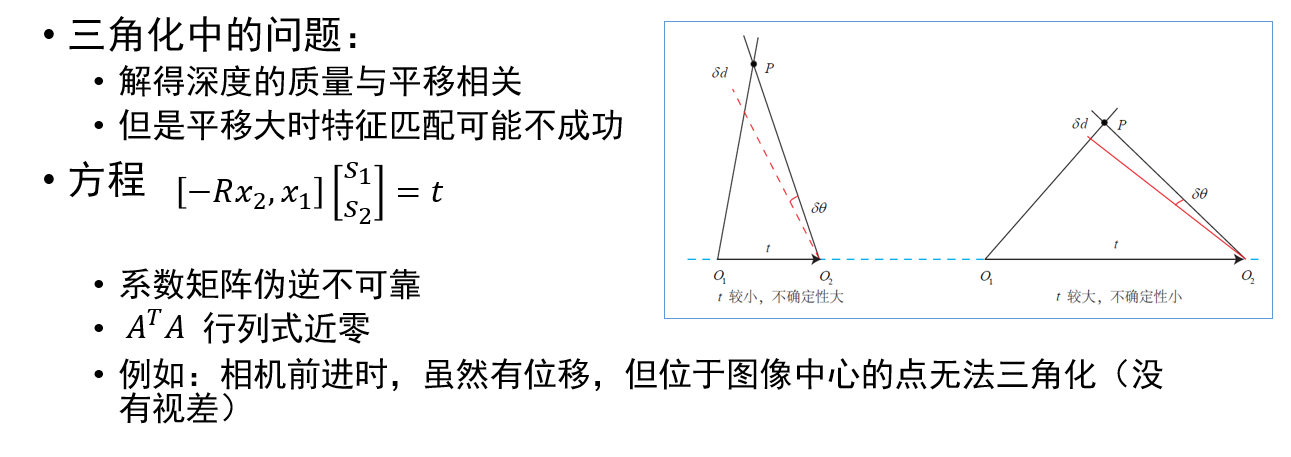
最新文章
- Andy - 又一款速度流畅的免费安卓 Android 模拟器 (支持手机无线控制电脑模拟器)
- cordova 打包发布正式版 apk
- C#中的常见集合类的比较
- 587A
- 编码实现Spring 利用@Resource注解实现bean的注入,xml实现基本数据类型的注入
- 元素ID命名规范
- (转) Deep Learning in a Nutshell: Reinforcement Learning
- Leetcode006 ZigZag Conversion
- mvc JavaScriptResult的用法
- TComponent,TControl,TWinControl,TGraphic的DefineProperties赏析与说明(不懂)
- DotNetOpenAuth实践
- UI自动化项目搭建(selenium+testng+java+maven)
- equals方法中变量在前和在后的区别
- Python+selenium 2【测试报告】
- python安装pbkdf2 遇到错误TypeError: __call__() takes exactly 2 arguments (1 given)
- PHP 操作 MySQL 执行数据库事务
- Linux下将使用rm删除的文件显示在回收站中
- @Resource 注解的使用
- js url参数和对象互转
- [python]小技巧集锦